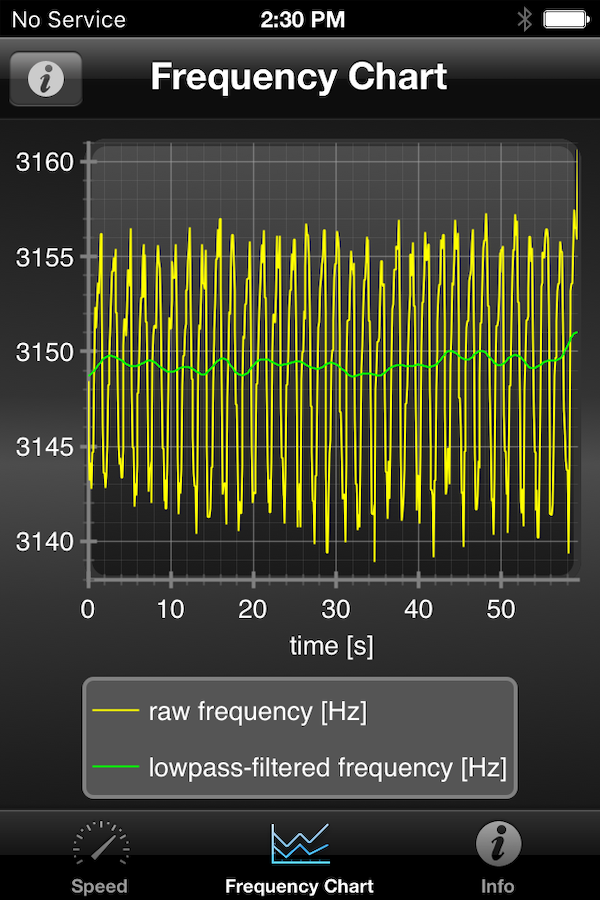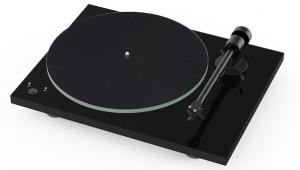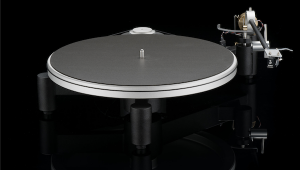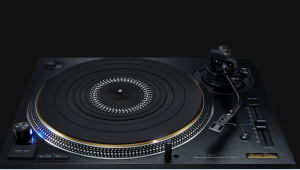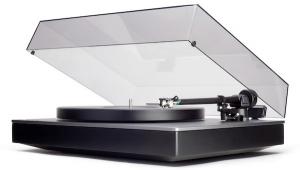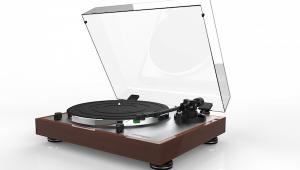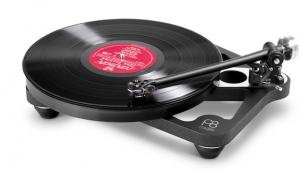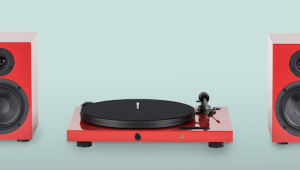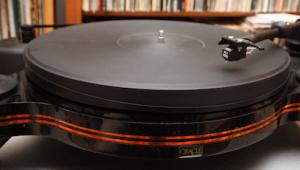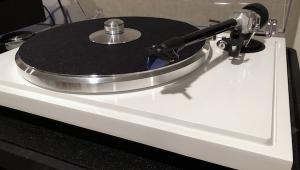Music Hall Introduces its "Stealth" Direct Drive Turntable

Music Hall’s Roy Hall is kind of like that. He figured out a way to be in the turntable business for decades without having to invest in a turntable factory.
Today there are many players in the turntable business who don’t own their own factory, but Roy was a pioneer. He’s also owned more than few turntables and as a longtime friend of Linn’s founder and fellow Scotsman Ivor Tiefenbrun, no doubt the two indulged in many soused turntable design discussions, though probably little of it was retained by either one.
Being a personable and forward looking fellow, Roy forged an early relationship with Heinz Lichtenegger, another forward looker and modern era turntable pioneer who did own a turntable factory and thus in 1998 was born the MMF line of Music Hall turntables manufactured at the Pro-Ject factory to Mr. Hall’s specifications.
Hall’s Pro-Ject build ‘tables utilize some familiar-looking components including carbon fiber arms but also incorporate Hall’s own unique thinking about damping and isolation, which led to the company’s distinctive top of the line “layer cake” plinth look.
While in the early days Pro-Ject probably needed the OEM business to keep the factory running full throttle, that’s no longer the case, yet Mr. Lichtenegger clearly is not abandoning his old friend, though he probably no longer needs the outside business—not that I know any of this for certain: it’s just surmisal, though I do know for certain that the Pro-Ject factory is “booked” for production months into the future.
The Music Hall Stealth Turntable
Reaching “down market” in the face of low priced competition has been a difficult challenge for most manufacturers and even for those who design and market turntables without having invested in kitchens.
Music Hall has hit those lower prices points—as low as $299 including built in phono preamp— by contracting with a Taiwanese manufacturer that supplies “built to order” turntables to many well-known brands. It doesn’t take a particularly sharp eye to notice.
However, with the Stealth, the brand’s first direct drive turntable (and so new it’s not yet on the company’s website), Mr. Hall is trying something else: using that same manufacturer to produce a somewhat more costly, feature packed direct drive turntable that includes a pre-installed $239 Ortofon 2M Blue priced at $1495.
The new Stealth features include push button 33 1/3, 45 and 78rpm electronic speed control, auto shut off at end of play, an electricity saving “auto standby” mode and a set of RCA/RCA phono cables. It also incorporates a VTA/SRA “on the fly” feature I’ve not previously seen on that very familiar tone arm. Perhaps others have used it, but I’ve not seen it.
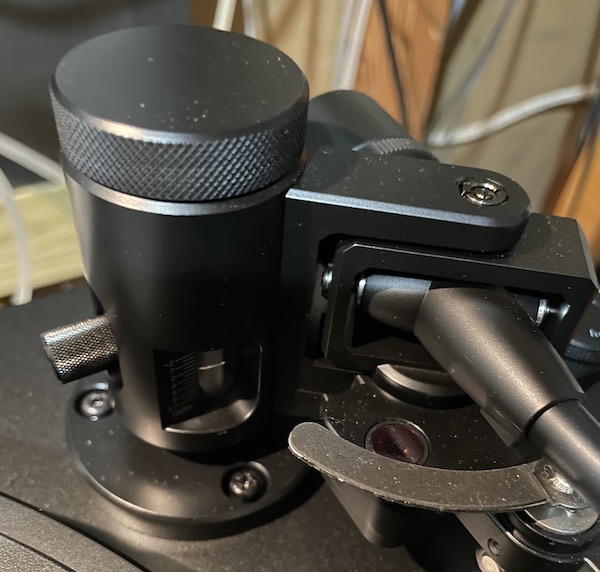
The arm is a 9” (230mm) effective length “S” shaped static balance design with a 22 degree offset angle and a standard detachable head shell, which of course is particularly useful if you plan on playing 78s or mono LPs.
More importantly, Mr. Hall has contracted for an unusually heavy, multi-layer and well-damped chassis as well as large, viscous-elastomer damped height-adjustable feet and a 4 pound, elastomer-damped die-cast aluminum platter (that’s what the instructions say it is, but it appears to me to be machined aluminum) that’s more massive and certainly far better damped than what’s typically found on turntables at this price point. The entire assemblage weights 24 pounds.
Another oddity in the manual is that it lists “audio specifications” that appear to have been “cut and pasted” from a model that includes a built-in phono preamp, which this turntable does not. Why else would it include channel separation and S/N ratio?
The direct drive motor is a brushless, low torque design that appears “familiar looking” (based upon what’s visible) on previous direct drive models I’ve reviewed manufactured for other companies by this Taiwanese company.
The bottom line is, Mr. Hall has spec’d from a high quality supplier a smartly conceived, feature-filled attractive design and priced it competitively. It’s not “cheap” but it’s also not expensive and if it performs well, it offers a great deal for the money. Oh, Hall saved money by offering a velvety soft dust cover instead of the usual hinged clear, rigid plastic one. I’ve not had a turntable with a dust cover for decades, so I think it’s a smart way to save money to keep the price down.
Measured Performance
A high resolution strobe disc made by Clearaudio demonstrated that the platter ran on speed at 33 1/3 and 45 and just slightly slow at 78, which is no big deal especially since 78s were often if not always “off” by a small amount.
Looking at the Platterspeed app graph and numbers also show that the platter spun at or very close speed (too small a deviation to matter) and deviations were more than reasonable given the turntable’s price point. That green line can look very flat if you’re willing to spend a great deal more money.
The Shaknspin measurements were equally good and basically confirmed the above:
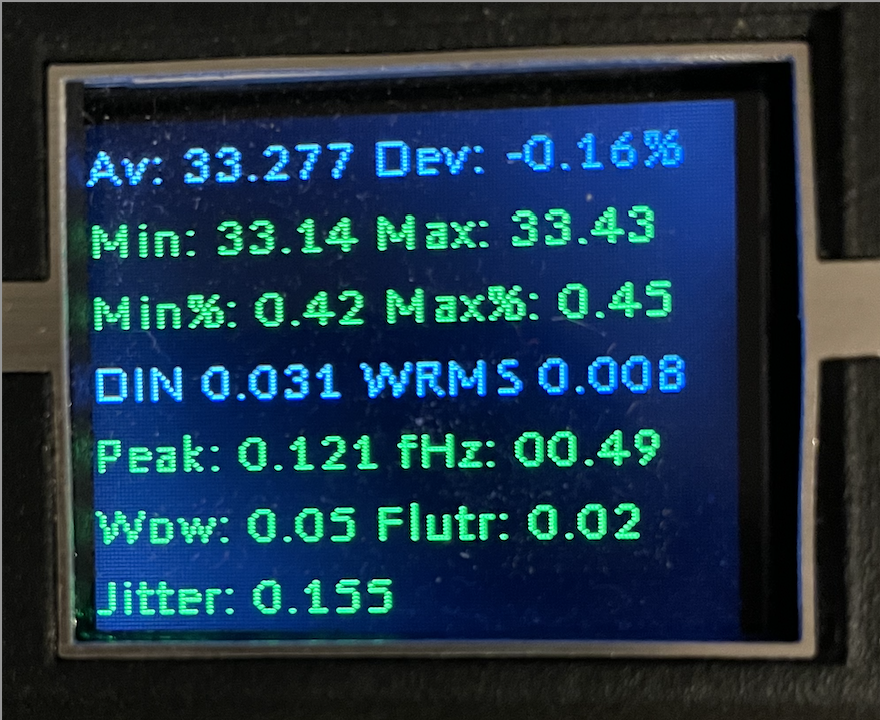
Please keep in mind that these measurement devices produce results that are useful in relative terms but hardly dispositive of turntable performance. While they are less than perfect measurement devices (and that’s true of every test record!), over time I’ve seen that the better turntables consistently produce better measured and visual results.
“Tap tests” on both the stand upon which the turntable sat and on the plinth itself demonstrated that the Stealth is in that regard extremely “stealthy” and performed better than some turntables costing 3X more. There are a few companies that try everything to achieve this performance level but never manage and always produce “lively” plinths and far less effective isolation.
Sonic Performance
Unlike some other moderately priced ‘tables that both transmit outside vibrations and resonate internally (the “tap test” isn’t 100% foolproof but it provides a pretty good idea), the Stealth’s low resonance performance and excellent rejection of external vibrational energy correctly predicted that its sound would be neutral rather than “warm” and that bass performance would be clean and “fast” and not soft and “full” sounding.
The Stealth was lean and clean in the best senses of those words. If you want warmth get it from the transducer. The Ortofon 2M Blue does not have a “rich, warm” sound and the Stealth did not add it. It does, however, have a pleasingly concise, focused sound and the Stealth delivered it.
Just delivered by mail were two offerings from The Tipitina Record Club. I couldn’t resist playing Professor Longhair Fess at Home (TRC-0101), a 1973 recording produced at his home by Quint Davis, now producer of the New Orleans Jazz & Heritage Festival founded by George Wein. Glad I did!
Despite having no reference point since I’ve not before heard the record, I can confidently write that the Stealth does the “rhythm’n’pacing” thing very well. Its presentation of Professor Longhair (a/k/a Henry Roeland Byrd)’s piano was coherent, especially on the bottom octaves where the ‘table didn’t soften or add warmth. Percussionist Alfred “Uganda” Roberts’ percussion, working in lockstep with Byrd, popped nicely behind and the living room ambience floated nicely in the background. Byrd’s vocalizing (couldn’t really call it singing) sat nicely and three dimensionally in the foreground. When I played it again on the reference rig while everything popped up a few major notches in terms of harmonic structure, three dimensionality, transparency and stage depth, the overall picture was pleasingly recognizable, especially rhythmically and timbrally.
The second record from the Tipitina’s Record Clug sent my way is James Booker’s True-Live at Tipitina’s (TRC-0104). If Booker’s dazzling solo take on “Malaguena” doesn’t get your heart racing, it’s either because the dancing keys have already stopped it or your turntable can’t keep up with the action. Again the $1500 ‘table did a great job communicating the rhythmic message but fell short on the harmonic and dynamic structure compared to a rig costing well over 100X as much. But without comparison the Stealth driving the QHW “The Vinyl” phono preamp kept me involved and kind of overwhelmed by Booker’s magical fingers. Neither of these records are of “audiophile” quality but they are direct, exciting and immediate musical documents.
The first drum “pop” on Lee Morgan’s “The Sidewinder” from the now sold out 12 LP set The Complete Live at the Lighthouse (Blue Note B0031954-01) sealed the deal for me.The biggest limitation here is the pretty good Ortofon Blue but no doubt this arm can handle a far more costly and sophisticated cartridge and with extra head shells available for $35.
I happened to have “lying around” an Adcom Crosscoil low output moving coil cartridge mounted on a compatible head shell. This cartridge had been rebuilt by The Garrott Brothers (the real guys—not long before they committed suicide along with their wives). That produced an enormous sonic change, not surprisingly, adding layers of harmonic integrity, richness, warmth and detail resolution, proving my point (at least to me) that this Stealth turntable is a remarkably neutral carrier that more expresses the cartridge being used with it than the record spinner itself.
Conclusion
Music Hall waited more than 20 years before launching a direct drive turntable. It was worth the wait if you are into direct drive. Not everyone is. The belt die-hards probably will not be interested but those of you who might be interested in a moderately priced, low torque direct drive spin that’s intended to compete with the “T” brand, ought to consider the Stealth before making your purchase. I wish I had a comparably priced “T” brand model here to do a direct comparison, but I do not.
Therefore, I’ll conclude by saying the Stealth is a stylish, well-performing and fine sounding, moderately priced, well-damped and isolated direct drive turntable, the sound of which is limited mainly by your choice of cartridge. It sounds timbrally well-balanced but somewhat harmonically astringent with the supplied $230 Ortofon 2M Blue but consider that observation was made using a system costing more than the average American home. Fitted with a better cartridge, the Stealth might have fooled some listeners for at least a short time into thinking the ‘table was commensurately priced with the rest of kthe system. According to Mr. Hall, expect the Stealth to be widely available in October of 2021.

